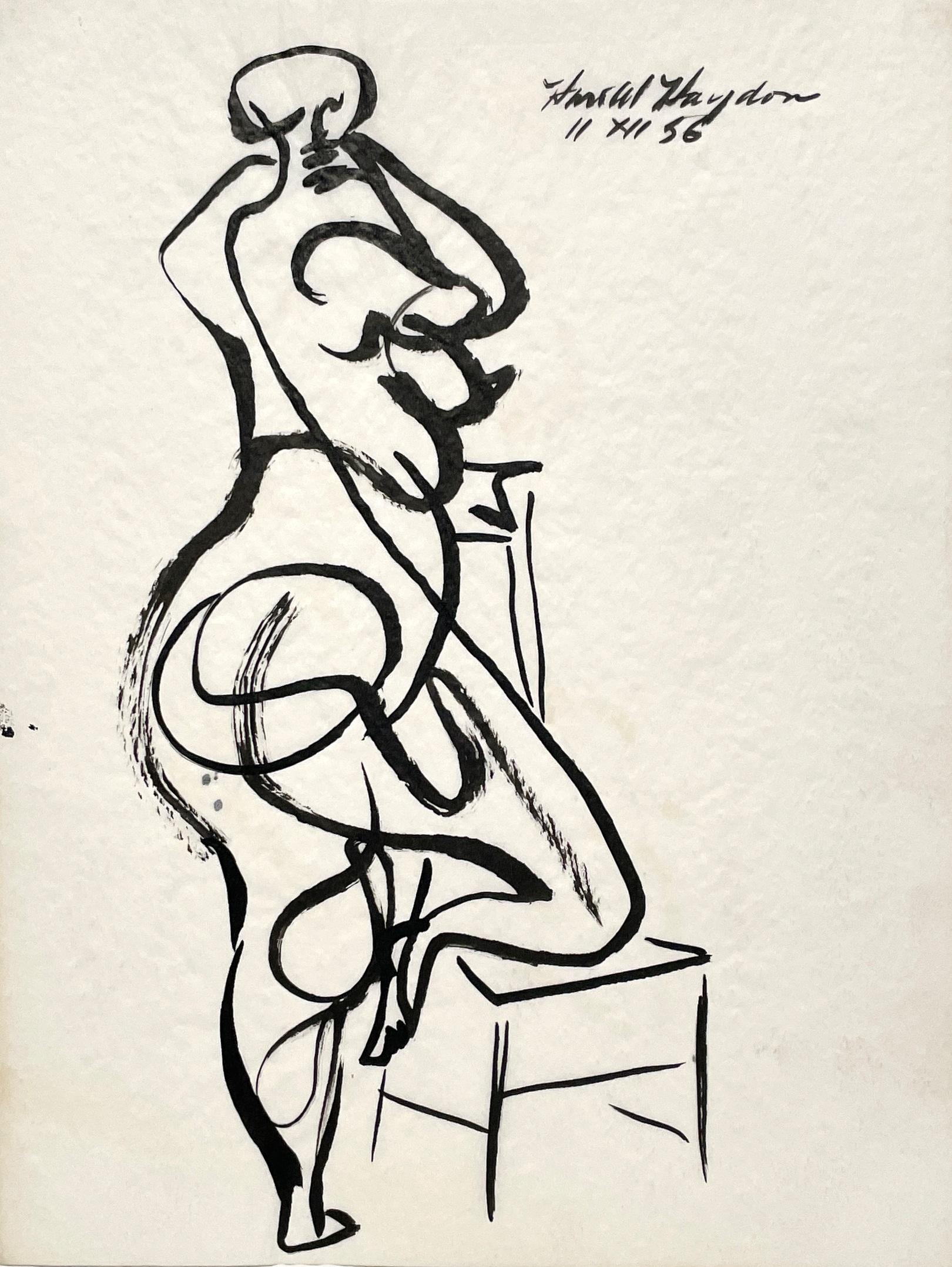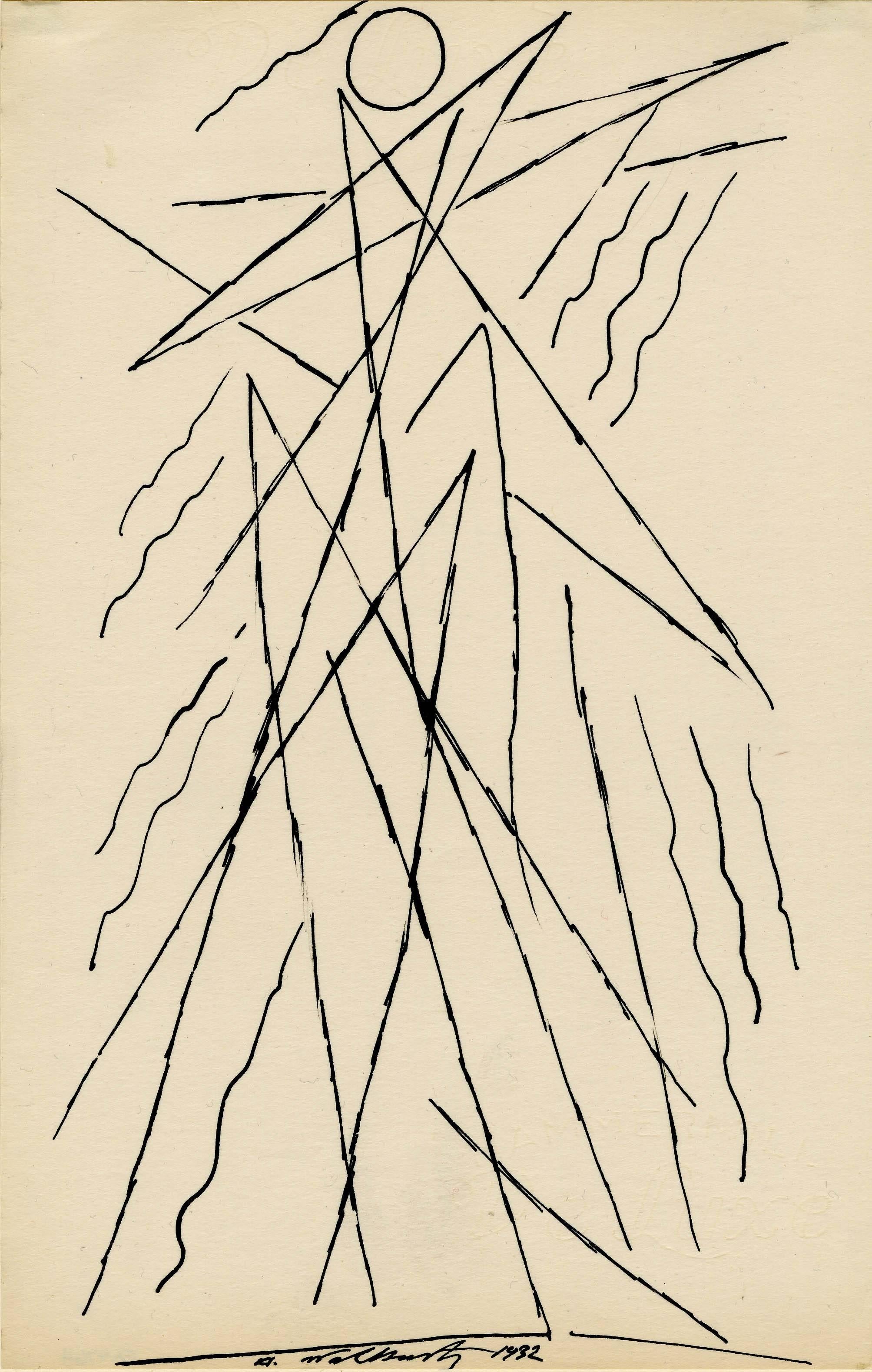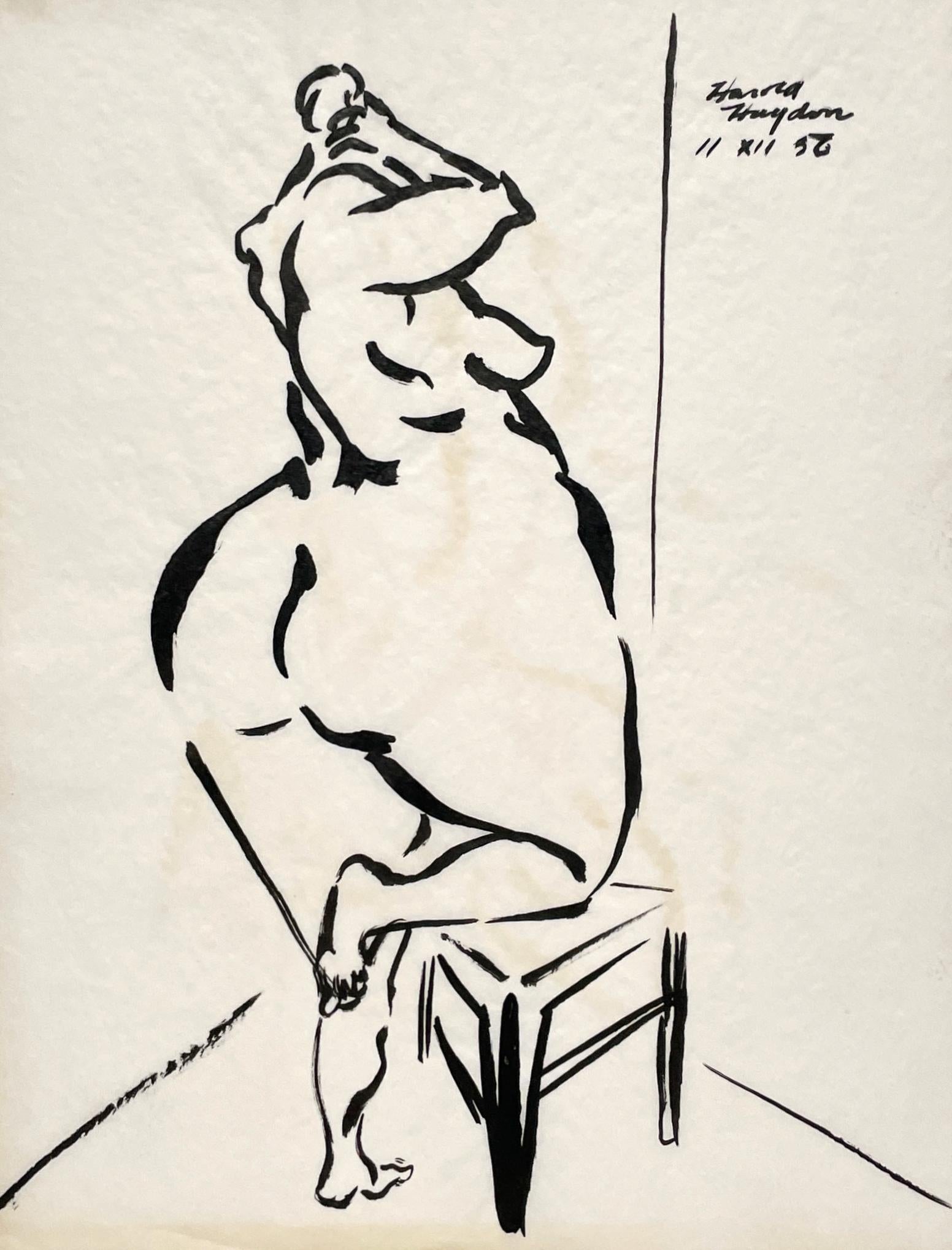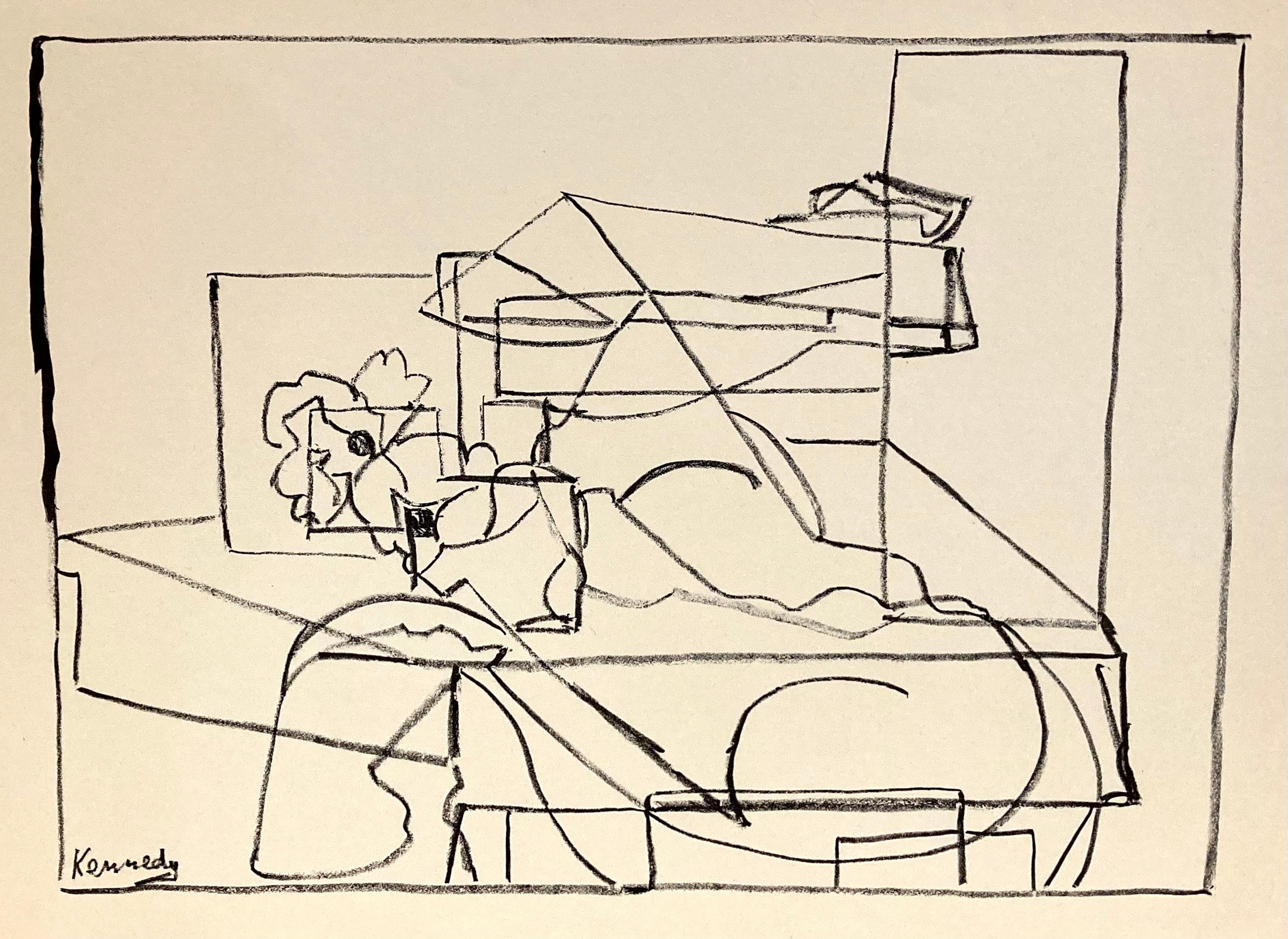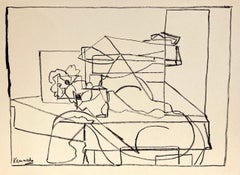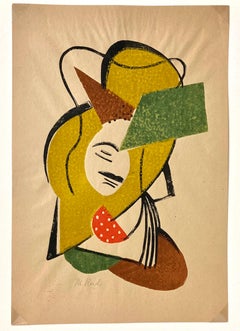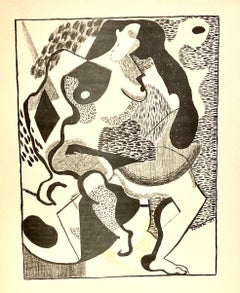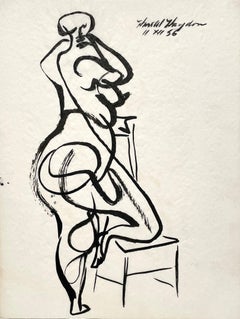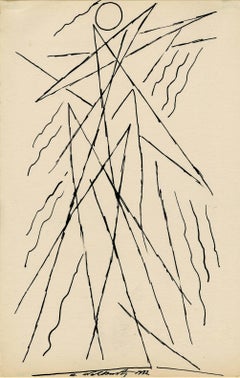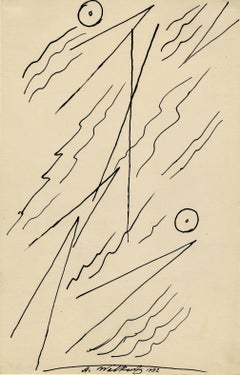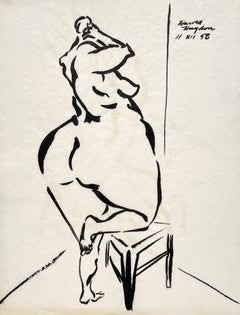Items Similar to Alice Earl Lyall, (Abstraction -- with Figure)
Want more images or videos?
Request additional images or videos from the seller
1 of 5
Alice Earl LyallAlice Earl Lyall, (Abstraction -- with Figure)1937
1937
$600
£466.10
€528.86
CA$857.89
A$938.55
CHF 490.19
MX$11,215.89
NOK 6,158.52
SEK 5,796.14
DKK 3,949.44
About the Item
This print was made for the American Abstract Artists Portfolio, 1937. All the images were lithographs made on zinc plates. Usually they were signed or initialed in the image -- on the plate, as this one is. As a group they explored abstraction in the 1930s, while maintaining their individual styles. The plan was to make an edition of 500 portfolios although it seems highly unlikely that this was accomplished.
Alice Earl Lyall (1908-2013) was one of the founders of the group.
The dimensions, 9 1/4 x 12 inches, are for the sheet.
- Creator:Alice Earl Lyall (1908 - 2013, American)
- Creation Year:1937
- Dimensions:Height: 4.73 in (12 cm)Width: 3.65 in (9.25 cm)
- Medium:
- Movement & Style:
- Period:
- Condition:Very minor toning at edges of sheet and one tiny fold at upper right corner. This should be clear in the photo of the full sheet.
- Gallery Location:New York, NY
- Reference Number:1stDibs: LU141028504722
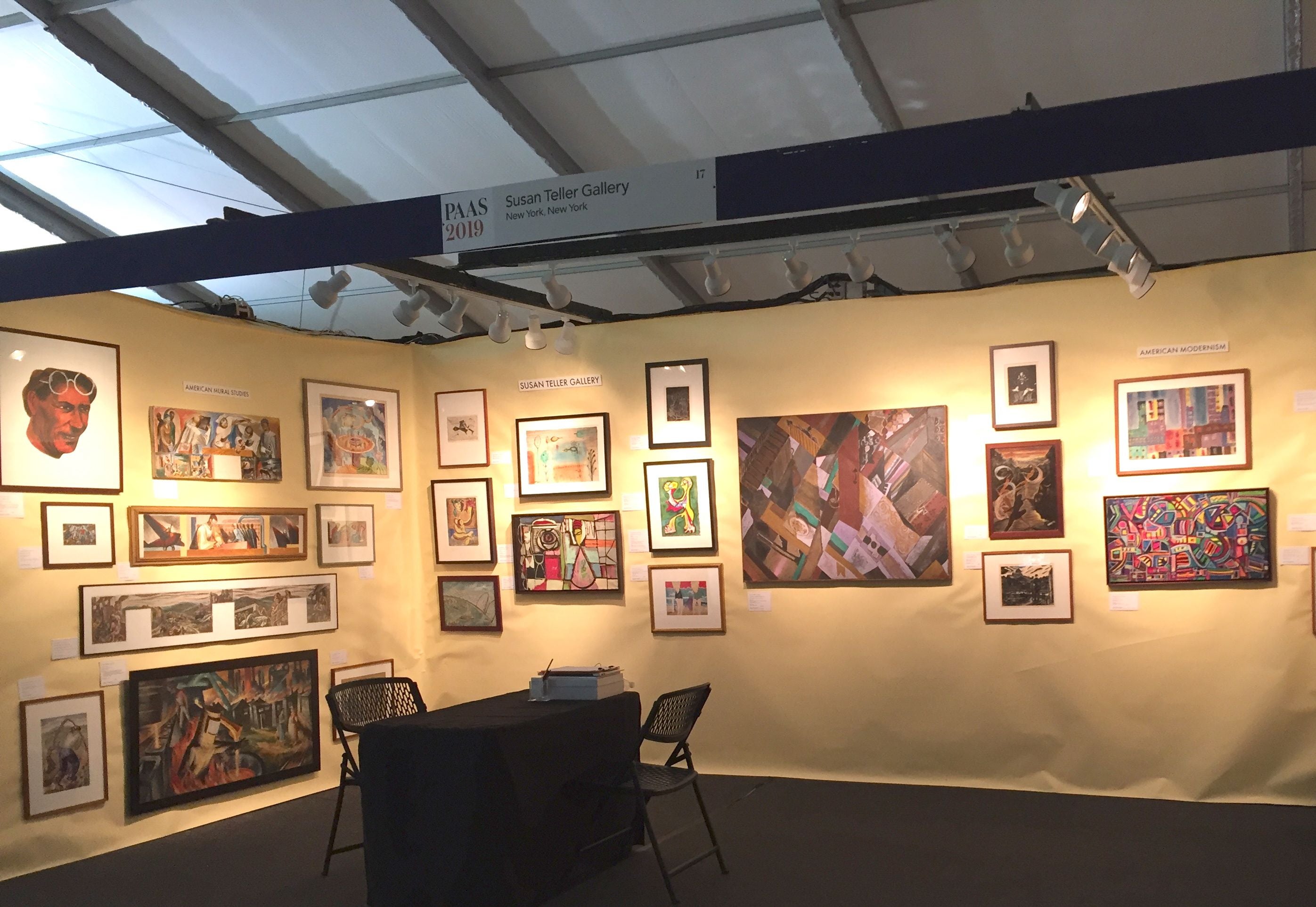
About the Seller
4.9
Gold Seller
Premium sellers maintaining a 4.3+ rating and 24-hour response times
Established in 1988
1stDibs seller since 2020
128 sales on 1stDibs
Typical response time: 5 hours
- ShippingRetrieving quote...Shipping from: New York, NY
- Return Policy
More From This Seller
View AllM. Kennedy, (Interior)
Located in New York, NY
This print was made for the American Abstract Artists Portfolio, 1937. All the images were lithographs made on zinc plates. Usually they were signed or initialed in the image -- on t...
Category
1930s Abstract Abstract Prints
Materials
Lithograph
Ibram Lassaw, (Abstraction)
By Ibram Lassaw
Located in New York, NY
This print was made for the American Abstract Artists Portfolio, 1937. All the images were lithographs made on zinc plates. Usually they were signed in the image -- on the plate, as this one is. As a group they explored abstraction in the 1930s, while maintaining their individual styles. The plan was to make an edition of 500 portfolios although it seems highly unlikely that this was accomplished.
Ibram Lassaw (1913-2003) was primarily known for his sculpture. Born in Egypt to a Russian family...
Category
1930s Abstract Abstract Prints
Materials
Lithograph
Martha Reed, (Color Abstraction) (Head?)
By Martha Reed
Located in New York, NY
Martha Reed was the daughter of the artist Doel Reed and as an adult she joined her parents in Taos, New Mexico.
There she designed clothes with a south-we...
Category
Mid-20th Century American Modern Abstract Prints
Materials
Linocut
Ray Kaiser, (Abstracted Seated Woman)
Located in New York, NY
This print was made for the American Abstract Artists Portfolio, 1937. All the images were lithographs made on zinc plates. Usually they were signed or initialed in the image -- on the plate, as this one is. As a group they explored abstraction in the 1930s, while maintaining their individual styles. The plan was to make an edition of 500 portfolios although it seems highly unlikely that this was accomplished. The Whitney Museum of American Art has a set.
The dimensions, 12 x 9 1/4 inches, are for the sheet; this work signed and dated in the plate.
Ray Kaiser...
Category
1930s Abstract Abstract Prints
Materials
Lithograph
Byron Browne, (Abstraction)
By Byron Browne
Located in New York, NY
This print was made for the American Abstract Artists Portfolio, 1937. All the images were lithographs made on zinc plates. Usually they were signed in the image -- on the plate, as ...
Category
1930s Abstract Abstract Prints
Materials
Lithograph
Harry Bowden, (Seated Figure)
By Harry Bowden
Located in New York, NY
This print was made for the American Abstract Artists Portfolio, 1937. All the images were lithographs made on zinc plates. Usually they were signed or initialed in the image -- on t...
Category
1930s Abstract Abstract Prints
Materials
Lithograph
You May Also Like
An Avant-Garde, Mid-Century Modern Abstract Female Figure Study by Harold Haydon
By Harold Haydon
Located in Chicago, IL
A Dynamic, Avant-Garde, Mid-Century Modern Abstract Female Figure Study by Harold Haydon (Am. 1909-1994). A striking, black & white figural studio ink drawing on paper depicting an...
Category
Mid-20th Century American Modern Abstract Drawings and Watercolors
Materials
Paper, Ink
Abstraction
By Abraham Walkowitz
Located in Fairlawn, OH
Signed and dated in ink lower center
Provenance:
Charlotte Bergman, noted collector and patron of Walkowitz. See photo for additional information.
Category
1930s Modern Abstract Drawings and Watercolors
Materials
Ink, Pen
Abstraction
By Abraham Walkowitz
Located in Fairlawn, OH
Untitled Abstraction
Pen and ink on paper, 1932
Signed and dated in ink lower center
Condition: Excellent
Sheet/Image size: 10 3/8 x 6 1/4 inches
Frame size: 16 1/2 x 12 1/2"
Provena...
Category
1930s Abstract Geometric Abstract Drawings and Watercolors
Materials
Ink, Pen
An Avant-Garde, Mid-Century Modern Abstract Female Figure Study by Harold Haydon
By Harold Haydon
Located in Chicago, IL
A Dynamic, Avant-Garde, Mid-Century Modern Abstract Female Figure Study by Harold Haydon (Am. 1909-1994). A striking, black & white figural studio ink drawing on paper depicting an...
Category
Mid-20th Century American Modern Abstract Drawings and Watercolors
Materials
Paper, Ink
Untitled
By Leon Kelly
Located in Fairlawn, OH
Untitled
Pastel on paper, 1922
Signed with the artist's initials in pencil
Provenance: Estate of the artist
Francis M. Nauman (label)
Private collection, NY
A very early abstract/cubist work by Kelly. Created while the artist was studying with Arthur Carles in Philadelphia.
Leon Kelly (October 21, 1901 – June 28, 1982) was an American artist born in Philadelphia, PA. He is most well known for his contributions to American Surrealism, but his work also encompassed styles such as Cubism, Social Realism, and Abstraction. Reclusive by nature, a character trait that became more exaggerated in the 1940s and later, Kelly's work reflects his determination not to be limited by the trends of his time. His large output of paintings is complemented by a prolific number of drawings that span his career of 50 years. Some of the collections where his work is represented are: The Metropolitan Museum in New York, The Whitney Museum of American Art, the Museum of Modern Art, the Philadelphia Museum of Art, and Boston Public Library.
Biography
Kelly was born in 1901 at home at 1533 Newkirk Street, Philadelphia, PA. He was the only child of Elizabeth (née Stevenson) and Pantaleon L. Kelly. The family resided in Philadelphia where Pantaleon and two of his cousins owned Kelly Brothers, a successful tailoring business. The prosperity of the firm enabled his father to purchase a 144-acre farm in Bucks County PA in 1902, which he named "Rural Retreat" It was here that Pantaleon took Leon to spend every weekend away from the pressures of business and from the disappointments in his failing marriage. Idyllic and peaceful memories of the farm stayed with Leon and embued his work with a love of nature that emerged later in the Lunar Series, in Return and Departure, and in the insect imagery of his Surrealist work. "If anything," he once said,"I am a Pantheist and see a spirit in everything, the grass, the rocks, everything."
At thirteen, Leon left school and began private painting lessons with Albert Jean Adolphe, a teacher at the School of Industrial Art (now the University of the Arts) in Philadelphia. He learned technique by copying the works of the old masters and visiting the Philadelphia Zoo, where he would draw animals. Drawings done in 1916 and 1917 of elephants, snakes and antelope, as well as copies of old master paintings by Holbein and Michelangelo, heralded an impressive emerging talent. In 1917, he studied sculpture with Alexander Portnoff but his studies came to an abrupt halt with the start of World War I. Being too young to enlist, he joined the Quartermaster Corp at the Army Depot in Philadelphia, where he served for more than a year loading ships with supplies and, along with other artists, working on drawings for camouflage.
By 1920, the family's fortunes drastically changed. His father's business had failed due to the introduction of ready made clothing and his marriage, unhappy from the beginning, dissolved. Broken by circumstance Pantaleon left Philadelphia to begin a wandering existence looking for work leaving Leon to support his mother and grandmother. He found a job in 1920 at the Freihofer Baking Company where he worked nights for the next four years. Under these circumstances Leon continued to develop his skills in drawing and painting and learned of the revolutionary developments in art that were taking place in Paris.
During the day he was granted permission to study anatomy at the Philadelphia School of Osteopathy where he dissected a cadaver and perfected his knowledge of the human figure. He also met and studied etching with Earl Horter, a well known illustrator, who had amassed a significant collection of modern art which included work by Brancusi, Matisse, and Cubist works by Picasso and Braque. Among the artists around Horter was Arthur Carles, a charismatic and controversial painter who taught at the Pennsylvania Academy of Fine Arts. Leon enrolled in the Academy in 1922, becoming what Carles described as, "his best student".
In the next three years Leon work ranged from academic studies of plaster casts, to pointillism, to landscapes of Fairmount Park in Philadelphia, as well as a series of pastels showing influences from Matisse to Picasso. Clearly influenced by Earl Horter's collection and Arthur Carles he mastered analytical cubism in works such as The Three Pears, 1923 and 1925 experimented with Purism in Moon Behind the Italian House. In 1925 Kelly was awarded a Cresson Scholarship and on June 14 he left for Europe.
Paris
The first trip to Europe lasted for approximately three and a half months and introduced Kelly to a culture and place where he felt he belonged. Though he returned to the Academy in the Fall, he left for Europe again a few months later to begin a four-year stay in Paris. He moved into an apartment at 19 rue Daguerre in Paris and began an existence intellectually rich but in creature comforts, very poor. "I kept a cinderblock over the drain in the kitchen sink to keep the rats out of the apartment" he once explained. He frequented the cafes making acquaintances with Henry Miller, James Joyce and the critic Félix Fénéon as well as others. His days were split between copying old master paintings in the Louvre and pursuing modernist ideas that were swirling through the work of all the artists around him. The Lake, 1926 and Interior of the Studio, 1927, now in the Newark Museum.
Patrons during this time were the police official Leon Zamaran, a collector of Courbets, Lautrecs and others, who began collecting Kelly's work. Another was Alfred Barnes of the Barnes Collection in Philadelphia.
In 1929 Kelly married a young French woman, Henriette D'Erfurth. She appears frequently in paintings and drawings done between 1928 and the early 1930s.
Philadelphia
The stock market crash of 1929 made it impossible to continue living in Paris and Kelly and Henriette returned to Philadelphia in 1930. He rented a studio on Thompson Street and began working and participating in shows in the city's galleries. Work from 1930 to 1940 showed continuing influences and experimentation with the themes and techniques acquired in Paris as well as a brief foray into Social Realism. The Little Gallery of Contemporary Art purchased the Absinthe Drinker...
Category
1920s Abstract Abstract Drawings and Watercolors
Materials
Pastel
$4,000
Abstract Composition - Original Lithograph - Mid-20th Century
Located in Roma, IT
Dancing figure in the darkness is an original lithograph on white paper realized by an Anonymous artist in the 1960s.
In very good conditions.
The artwork is created beautifully t...
Category
1960s Abstract Abstract Prints
Materials
Lithograph
